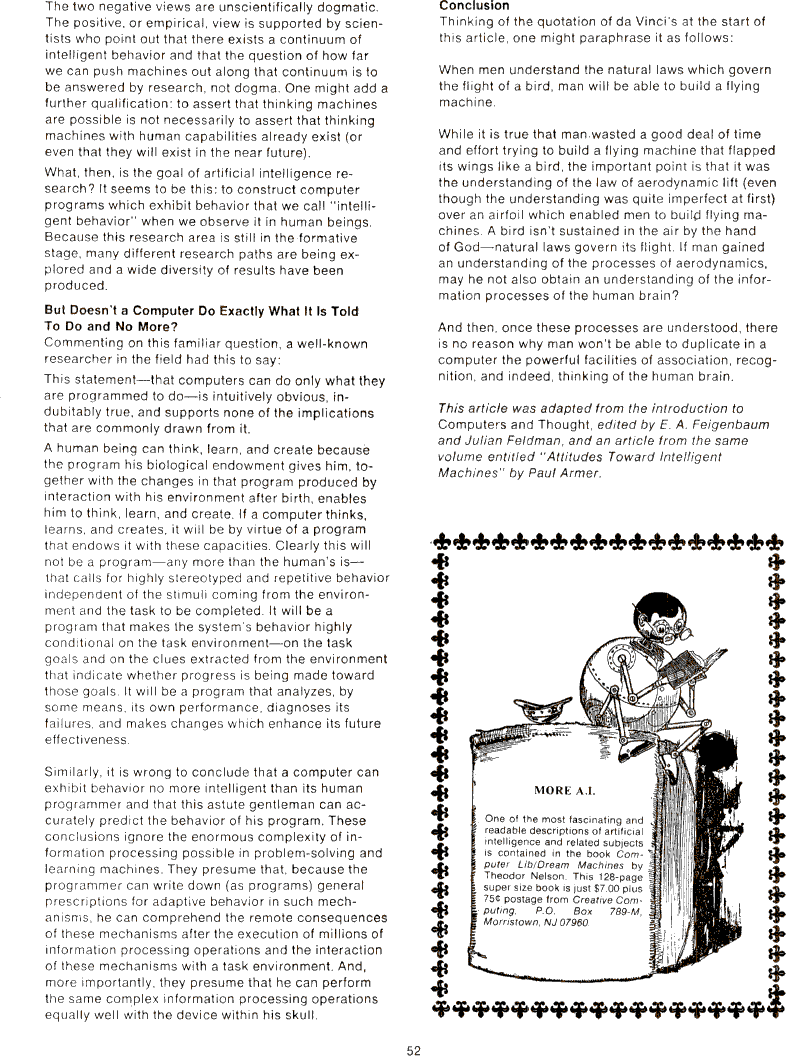The Best of Creative Computing Volume 2 (published 1977)
Can Computers Think?

The two negative views are unscientifically dogmatic. The positive, or
empirical, view is supported by scientists who point out that there exists a
continuum of intelligent behavior and that the question of how far we can push
machines out along that continuum is to be answered by research, not dogma. One
might add a
further qualification: to assert that thinking machines are possible is not
necessarily to assert that thinking machines with human capabilities already
exist (or even that they will exist in the near future).
What, then, is the goal of artificial intelligence research? It seems to be
this: to construct computer programs which exhibit behavior that we call
"intelligent behavior" when we observe it in human beings. Because this research
area is still in the formative stage, many different research paths are being
explored and a wide diversity of results have been produced.
But Doesn't a Computer Do Exactly What It Is Told To Do and No More?
Commenting on this familiar question, a well-known researcher in the field had
this to say:
This statement-that computers can do only what they are programmed to do-is
intuitively obvious, indubitably true, and supports none of the implications
that are commonly drawn from it.
A human being can think, learn, and create because the program his biological
endowment gives him, together with the changes in that program produced by
interaction with his environment after birth, enables him to think, learn, and
create. lf a computer thinks, learns, and creates, it will be by virtue of a
program that endows it with these capacities. Clearly this will not be a
program-any more than the human's is-that calls for highly stereotyped and
repetitive behavior independent of the stimuli coming from the environment and
the task to be completed. lt will be a program that makes the system's behavior
highly conditional on the task environment-on the task goals and on the clues
extracted from the environment that indicate whether progress is being made
toward those goals. It will be a program that analyzes, by some means, its own
performance, diagnoses its failures, and makes changes which enhance its future
effectiveness.
Similarly, it is wrong to conclude that a computer can exhibit behavior no more
intelligent than its human
programmer and that this astute gentleman can accurately predict the behavior of
his program. These conclusions ignore the enormous complexity of information
processing possible in problem-solving and learning machines. They presume that,
because the programmer can write down (as programs) general prescriptions for
adaptive behavior in such mechanisms, he can comprehend the remote consequences
of these mechanisms after the execution of millions of information processing
operations and the interaction of these mechanisms with a task environment. And,
more importantly, they presume that he can perform the same complex information
processing operations equally well with the device within his skull.
Conclusion
Thinking of the quotation of da Vinci's at the start of this article, one might
paraphrase it as follows:
When men understand the natural laws which govern the flight of a bird, man will
be able to build a flying
machine.
While it is true that man wasted a good deal of time and effort trying to build
a flying machine that flapped
its wings like a bird, the important point is that it was the understanding of
the law of aerodynamic lift (even though the understanding was quite imperfect
at first) over an airfoil which enabled men to build flying machines. A bird
isn't sustained in the air by the hand of God-natural laws govern its flight. lf
man gained
an understanding of the processes of aerodynamics, may he not also obtain an
understanding of the information processes of the human brain?
And then, once these processes are understood, there is no reason why man won't
be able to duplicate in a
computer the powerful facilities of association, recognition, and indeed,
thinking of the human brain.
This article was adapted from the introduction to Computers and Thought, edited
by E. A. Feigenbaum and Julian Feldman, and an article from the same volume
entitled "Attitudes Toward Intelligent Machines" by Paul Armer.
[image]MORE A.|.
One of the most fascinating and
readable descriptions of artificial
intelligence and related subjects
is contained in the book Computer Lib/Dream Machines by
Theodor Nelson. This 128-page
super size book is just $7.00 plus
75¢ postage from Creative Com~ puting, P.O. Box 789-M.
Morristown, NJ 07960,


